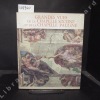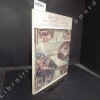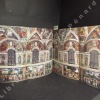11 books for « rossi bruno »Edit
-
Type
Book (6)
Music sheets (5)
-
Century
20th (9)
21st (2)
-
Topics
Architecture (1)
Berry (1)
Brazil (1)
Cinema (1)
Exhibition (1)
Italian (1)
Magazine (1)
Maine (1)
Newspapers press (1)
Photography (1)
Physics (2)
Religions (1)
Reviews (1)
Rossi tino (5)
Sciences & technique (1)
-
Countries
Denmark (1)
France (9)
United Kingdom (1)
-
Syndicate
ILAB (3)
SLAM (1)
High-Energy Particles
Prentice-Hall Incorporated, New York , Prentice-Hall Physics Series Malicorne sur Sarthe, 72, Pays de la Loire, France 1952 Book condition, Etat : Bon hardcover, editor's binding, under editor's black and yellow printed and illustrated dust-jacket grand In-8 1 vol. - 581 pages
many black and white text-figures and illustrations 1st edition, 1952 Contents, Chapitres : Preface, Contents, xii, Text, 569 pages - Introduction - Theory of electromagnetic interactions - Experimental methods - Elementary particles - Cascade showers - Experimental results on the electromagnetic interactions of high-energy particles in cosmic rays from artificial sources - Nuclear interactions of high-energy particles from artificial sources - Nuclear interactions of cosmic rays - Appendices, bibliography and index - Bruno Benedetto Rossi (né le 13 avril 1905 à Venise et mort le 21 novembre 1993 à Cambridge au Massachusetts) est un physicien expérimentateur italo-américain. Il fit des contributions majeures dans le domaine des rayons cosmiques et de la physique des particules de 1930 jusqu'aux années 1950, et défricha l'astronomie des rayons X et la physique des plasmas cosmiques dans les années 1960. - Durant la guerre, Rossi travailla d'abord comme consultant pour le développement du radar au Radiation Laboratory du Massachusetts Institute of Technology, puis à Los Alamos comme codirecteur du groupe des détecteurs responsable du développement de l'instrumentation des expériences nécessaires à la mise au point de la bombe atomique. À l'automne 1946, Rossi fut nommé professeur de physique au MIT où il créa le groupe des rayons cosmiques pour étudier la nature et l'origine des rayons cosmiques et les propriétés des particules sub-atomiques produites par l'interaction des rayons cosmiques avec la matière. À la fin des années 1950, quand les expériences utilisant des accélérateurs de particules avaient fini par dominer la physique expérimentale des particules, Rossi tourna son attention vers les études exploratoires rendues possibles par le récent développement des engins spatiaux. Au MIT, il monta des expériences utilisant des fusées qui permirent l'étude directe du plasma interplanétaire. Comme consultant chez American Science and Engineering, Inc., il définit les essais à l'aide de fusées qui permirent de découvrir la première source extra-solaire de rayons X, Scorpius X-1. Rossi fut nommé Institute Professor au MIT en 1965. Parmi ses contributions aux techniques électroniques appliquées à la physique expérimentale, citons l'invention du circuit à coïncidence (Florence 1930), du convertisseur temps-amplitude (Cornell 1942) et de la chambre d'ionisation rapide (Los Alamos, avec H. Staub en 1943). near fine copy, the dust-jacket is in near fine condition, nearly complete and clean, with minor wear, small parts are lightly torn on the borders, without any significant missing of paper, the inside part of the dust-jacket had been repared with adhesive in a nice way at the end of the book, else inside is fine, no markings, a rather nice copy
[Giovanni Carnovale called il Piccio] - Rossi, Francesco and Bruno Lorenzelli, eds.
Reference : 027076
(1974)
Il Piccio e artisti bergamaschi del suo tempo.
Rossi, Francesco and Bruno Lorenzelli, eds.: Il Piccio e artisti bergamaschi del suo tempo. Exhibition: Bergamo, Palazzo della Ragione, 1974. 186pp with 46 colour and 104 monochrome illustrations. Cloth. 24x23cms. Fully illustrated, descriptive catalogue of 133 works by Il Piccio and 13 by his contemporaries, giving provenance, exhibitions and bibliography where appropriate. With list of exhibitions, bibliography.
Fully illustrated, descriptive catalogue of 133 works by Il Piccio and 13 by his contemporaries, giving provenance, exhibitions and bibliography where appropriate. With list of exhibitions, bibliography
Archeo-thema - N°7, mars avril 2010- Cluny aux origines de la communaute- romainmotier, paray le monial, gigny, souvigny, baume les messieurs- exposition au louvre: meroe, un empire sur le nil- decouverte: les origines gauloises de toulouse ...
ARCHEODUNUM SAS. 2010. In-4. Broché. Bon état, Couv. convenable, Dos satisfaisant, Intérieur frais. 65 PAGES illustrées en couleur. . . . Classification Dewey : 70.49-Presse illustrée, magazines, revues
archeo thema revue d'archeologie et d'histoire - N°7 mars avril 2010 // sommaire : Cluny aux origines de la communaute- ecrire le chant a cluny- romainmotier, paray le monial, gigny, souvigny, baume les messieurs- exposition au louvre: meroe, un empire sur le nil- decouverte: les origines gauloises de toulouse - les moines et l'art par bruno phalip - decouvertes et chantiers en cours - ... Classification Dewey : 70.49-Presse illustrée, magazines, revues
Barelli Aimé,Rossi Tino,Claveau André,Mengo Jerry,François Jacqueline,Maine Norman,Mauric Jean-Paul,Bruno Pierrette,Noguez Jacky,Hills Gillian,Rapetti Robert,Arno Audrey - Paté André - Bonifay Fernand
Reference : 89621
(1960)
Partition de la chanson : Tu peux ...
Beuscher Paul 1960
Très bon état Format Coquille Piano
COLLECTIF - Texte d'Antoine P. Graziano - Exposition de François Rossi - Photographies de Bruno del Priore
Reference : 108940
(1976)
Grandes vues de la Chapelle Sixtine et de la Chapelle Pauline. Michel-Ange, Botticelli, Perugino, Signorelli, Ghirlandaio, Rosselli
1976 Editions Fonte - 1976 - In-4, broché, couverture à rabats et jaquette illustrées en couleurs - 99 p. - Nombreuses illustrations et reproductions photographiques en couleurs, dont de nombreuses dépliantes - Avec une carte dépliante
Bon état malgré bordures légèrement jaunis par le temps - Un tampon sur le sommaire - "Charnière" très légèrement à nues
Rossi Tino - Di Lazzaro E. - de Badet André,di Lazzaro Eldo,Bruno C.
Reference : 6124
(1936)
Bartira Miss,Berry Guy,Rossi Tino,Clair Bruno,Lumière Jean,Jossy Henri,Sorbier Jean - Bixio Cesare Andrea - Varna Henri,Marc-Cab,Cherubini B.
Reference : 21806
(1935)
Partition de la chanson : Violon dans la nuit (Un) Violono tzigano Parade du monde Casino de Paris
Bourcier 1935
Bon état Petit format
Val Kilmer Gabriel Byrne Vinnie Jones Anthony Lapaglia Bruno Kirby Mick Rossi Patrick Bergin Joanne Whalley Patsy Kensit Steve Jones Roy Dotrice Sile Bermingham Val Kilmer Gabriel Byrne
Reference : 89867
(2017)
ISBN : 3476475005661
Played
MEP Vidéo 2017 18x14x1cm. 2017. DVD.
FRENCH édition : zone 2 Europe - - en bon état de lecture - Expédition sous blister dans une enveloppe matelassée depuis la France
"GIACCONI, RICCARDO & HERBERT GURSKY & FRANK R. PAOLINI & BRUNO B. ROSSI.
Reference : 43476
(1962)
Evidence for X Rays from Sources Outside the Solar System. - [THE DISCOVERY OF COSMIC X-RAY SOURCES.]
(New York), American physical Society, 1962. Lex8vo. Volume 9, No. 11, December 1, 1962 of ""Physical Review Letters"", In the original printed blue wrappers. A very nice and clean copy externally as well as internally, near mint. Pp. 439-443. [Entire issue: 439-477].
First printing of Giocconi's seminal paper in which the discovery of cosmic x-ray sources is presented for the first time, thereby documenting the first observation of an x-ray source outside the Solar System. The x-ray detector was launched on a rocket to look for x-ray emissions from the Moon" instead they found a bright source of soft x-rays in the constellation Scorpius. This source, now known as Scorpius X-1, is the brightest x-ray source in the sky after the Sun. It has since been identified as a neutron star in a binary-star system some 9,000 light years away.The discovery had immense consequences for cosmology, since Hoyle's Hot Universe continuous creation theory could not account for this emission. Riccardo Giacconi received the Nobel Prize in Physics in 2002 for his discovery.
 Write to the booksellers
Write to the booksellers












